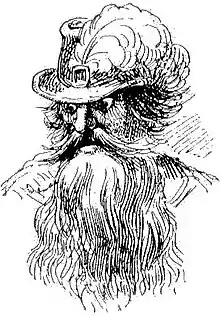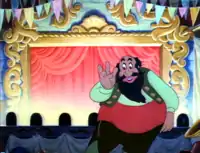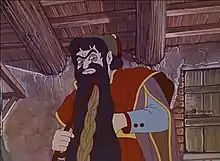Mangiafuoco
Mangiafuoco (/ˌmɑːndʒəˈfwoʊkoʊ/ MAHN-jə-FWOH-koh; Italian: [ˌmandʒaˈfwɔːko], literally "Fire-Eater") is a fictional character who appears in Carlo Collodi's 1883 book The Adventures of Pinocchio (Le avventure di Pinocchio). He is the theatre director and puppet-master of the Great Marionette Theatre.
| Mangiafuoco | |
|---|---|
| The Adventures of Pinocchio character | |
 Mangiafuoco, as illustrated by Enrico Mazzanti | |
| First appearance | The Adventures of Pinocchio |
| Created by | Carlo Collodi |
| In-universe information | |
| Species | Human |
| Gender | Male |
| Occupation | director of the Great Marionette Theatre |
| Nationality | Italian |
In the novel

Mangiafuoco is described as
...a large man so ugly, he evoked fear by simply being looked at. He had a beard as black as a smudge of ink and so long that it fell from his chin down to the ground: enough so that when he walked, he stepped on it. His mouth was as wide as an oven, his eyes were like two red tinted lanterns with the light turned on at the back, and with his hands, he sported a large whip made of snakes and fox tails knotted together.
Though imposing, Mangiafuoco is portrayed as easily moved to compassion, which he expresses by sneezing.
He is first encountered in Chapter X, after Pinocchio ruins one of his puppet shows by distracting the other puppets, and demands that Pinocchio be burned as firewood for his roasting mutton.
Moved by Pinocchio's lamentations, Mangiafuoco decides to burn one of his own puppets, Harlequin (Arlecchino), instead. When Pinocchio begs for Harlequin's life and offers to sacrifice himself in Harlequin's stead, he is refused by Mangiafuoco, who upon hearing that he is poor, gives Pinocchio five gold coins which are later seized by The Fox and the Cat (Il Gatto e la Volpe).
In other media
Stromboli (Disney)
| Stromboli | |
|---|---|
 Stromboli as he appears in Disney's Pinocchio | |
| First appearance | Pinocchio (1940) |
| Created by | Bill Tytla Walt Disney |
| Voiced by | Charles Judels Daws Butler (1954 record album)[1] |
| In-universe information | |
| Species | Human |
| Gender | Male |
| Occupation | Puppet maker |
| Nationality | Italian |
| Birthplace | Italy |
In the 1940 animated Disney film Pinocchio, Mangiafuoco is renamed Stromboli (in the Italian dub of the film, "Mangiafuoco" is Stromboli's epithet). The character is voiced by Charles Judels (who also voiced The Coachman in the same film), and animated by Bill Tytla. Unlike Mangiafuoco, who meets Pinocchio by chance, Stromboli buys Pinocchio from Honest John and Gideon and earns a great deal of money by showing Pinocchio on stage. Stromboli is at first portrayed as gruff and rude but kind-hearted, but he angrily locks Pinocchio in a cage, stating that once he is too old to work, he will be used as firewood, revealing his true nature as brutal, cruel, vicious, and arrogant. Pinocchio escapes with the help of the Blue Fairy and Jiminy Cricket, but is berated for lying to her and ignoring Jiminy's advice. Like all the villains in the film, the final fate of Stromboli is never stated, revealed, or implied. However, some imply that his show went bankrupt after losing his star attraction. The trait is also shared with The Coachman. He is also the first Disney villain to not be evil at first.
Reception and analysis
Despite his limited screen time, Stromboli is one of Disney's most infamous and acclaimed villains. The character has been praised by critics for possessing the ability to instill in audiences both laughter and fear.[2] Art critic Pierre Lambert has stated that "Tytla's innate sense of force is revealed in all its magnitude in the creation of the character of Stromboli,"[3] and animation historian Charles Solomon refers to the puppet master as "the grandest of all Disney heavies," while John Canemaker describes Stromboli as "an overweight monster of mercurial moods, capable of wine-soaked, garlic-breathed Old World charm one second, and knife-wielding, chop-you-up-for-firewood threats the next."[4] William Paul drew some parallelism:
It is not too difficult to regard Stromboli as burlesque of a Hollywood studio boss, complete with foreign accent. Disney's own relationship to the Hollywood power structure was always a difficult one, and his distrust of the moguls was well justified by his earliest experiences in the industry.[5]
During the premiere of Pinocchio, Frank Thomas sat in front of W.C. Fields, who, upon Stromboli's entrance, muttered to whoever was with him that the puppet master "moves too much." Michael Barrier agrees with Fields' criticism, considering Stromboli a "poorly conceived character" whose "passion has no roots... there is nothing in Stromboli of what could have made him truly terrifying."[6] Leonard Maltin disagrees, considering Pinocchio's encounter with the showman to be the wooden boy's "first taste of the seamy side of life... (Stromboli) tosses his hatchet into the remnants of another ragged marionette, now a pile of splinters and sawdust, a meekly smiling face the only reminder of its former 'life'."[7] Though the character is Italian, characteristics such as Stromboli's facial expressions, obsession with wealth, and long black 'goat's beard' have led some to make comparisons with Jewish stereotypes (particularly Hollywood moguls).[5]
Later portrayals

- In Giuliano Cenci's 1972 animated film The Adventures of Pinocchio (Un burattino di nome Pinocchio), Mangiafuoco's portrayal is true to the book in design and personality. In the English version he is renamed The Fire-Eater, translation of his original Italian name. He is voiced by Michele Gammino in the Italian version and by Bob Holt in the English dub.
- He appears in the 1972 miniseries The Adventures of Pinocchio, portrayed by Lionel Stander.
- Filmation's Pinocchio and the Emperor of the Night features a puppet master named Puppetino voiced by William Windom. When Pinocchio runs away to a carnival with the idea of finding work, Puppetino recognises him from when he was a puppet. In a nightmarish sequence, Puppetino turns Pinocchio back into a lifeless, wooden puppet through an unexplained, magical process. It is implied strongly that he has done this to other children also. Puppetino speaks in a cockney accent and is a gaunt, pale-skinned man with a red moustache and hair, thick lips and a cloak. He is also a henchman and servant of the titular Emperor, who later turns on Puppetino for cowardice and turns him into a puppet before he is set in fire.
- In Steve Barron's 1996 live action film The Adventures of Pinocchio, Mangiafuoco (who is played by Udo Kier) is renamed Lorenzini and is portrayed as the main antagonist of the film, encompassing three different villains from Collodi's story: the Puppet Master, The Coachman, and the Sea Monster. He initially adopts Pinocchio into his puppet troupe when he enlists Volpe and Felinet to bring Pinocchio to him. Lorenzini has a craving for chilli peppers, identified as the cause of his "fiery" breath. After Pinocchio accidentally sets Lorenzini's theatre on fire, Lorenzini begins luring bad naughty boys to Terra Magica, where the children inevitably drink cursed water which turns them into donkeys. Lorenzini, during a struggle with Pinocchio, falls into the water and becomes The Monstrous Whale.
- In the Happily Ever After: Fairy Tales for Every Child adaptation of Pinocchio, the character Mr. Buzzard (voiced by Garrett Morris) is based on Stromboli. Just like the Disney version, Red the Fox and Sporty the Cat sell Pinoak to him and Pinoak later escapes from him. In addition, Mr. Buzzard is seen in the shadows as the one who runs Fantastic Island.
- In Geppetto (2000), a television film broadcast on The Wonderful World of Disney, Mangiafuoco (again named Stromboli) is portrayed by Brent Spiner. He is portrayed as an unsuccessful puppeteer who constantly argues with his ventriloquist's dummy and other puppets. He captures Pinocchio in order to use him as the main attraction in his puppet show, thus warning him it will violate a contract he had him sign to perform in every show he holds. When Pinocchio runs away from the show and goes to Pleasure Island, Stromboli sets out to recapture him as well as Geppetto. When Geppetto and Stromboli arrives at Pleasure Island, they were both looking for Pinocchio, only for Stromboli to get kicked out of Pleasure Island while Geppetto learns that the rollercoaster has the dark magic that will turn boys into donkeys, as was the case with Pinocchio when Geppetto tries to save him from getting into the rollercoaster, but to no avail. When Pinocchio and Geppetto come home to the toy shop after escaping the whale, Stromboli shows them the contract and wants Pinocchio back with him. Geppetto offers his whole shop in exchange. When the Blue Fairy refuses to help Geppetto save Pinocchio, Geppetto pleads and begs to give him one last chance. The Blue Fairy turns him into a real boy and frightens Stromboli away with her magic.
- Mangiafuoco appears in the 2002 Pinocchio film portrayed by Franco Javarone while his English dub voice was provided by Kevin James.
- In the 2007 film Shrek the Third, a Puppet Master (voiced by Chris Miller) similar to Mangiafuoco appears who refers to Pinocchio as his "star puppet" and is a villainous character like Disney's Stromboli. As Prince Charming rouses the band of villains at the Poison Apple tavern to join him in order to take over Far Far Away so he can become king, he says to the Puppet Master that "Your star puppet abandons the show to go and find his father". His only line is "I hate that little wooden puppet".
- Though he is not seen, his name is used in the title of the Shrek the Third video-game level "Stromboli's Workshop." A picture of himself could also be seen in the video game level.
- Mangiafuoco appears in the 2008 Pinocchio miniseries, portrayed by Maurizio Donadoni.
- He appears in the 2012 Pinocchio film, voiced by Rocco Papaleo in the Italian version and by Vlasta Vrána in the English dub.
- In the live-action Italian film Pinocchio (2019), co-written, directed and co-produced by Matteo Garrone, Mangiafuoco is portrayed by Gigi Proietti, while his English dub voice is provided by Paolo Marchese. This is Proietti's last appearance before his death on November 2, 2020, though he will make a posthumous appearance in the film Io sono Babbo Natale.
- Mangiafuoco is set to be voiced by Ron Perlman in the 2021 stop-motion Netflix film Pinocchio, produced, written and directed by Guillermo del Toro.
References
- "June Foray as Walt Disney's "Pinocchio & "Ferdinand the Bull"". cartoonresearch.com. Retrieved 9 September 2020.
- Frank Thomas and Ollie Johnston, "The Disney Villain" (Hyperion, United States, 1993) ISBN 1-56282-792-8
- Pierre Lambert, Pinocchio (Hyperion, Spain, 1995) ISBN 0-7868-6247-5
- Charles Solomon, "The History of Animation Enchanted Drawings" (Alfred A. Knopf, New York, 1989) ISBN 0-394-54684-9
- Robin Allan, "Walt Disney and Europe" (Indiana University Press, Indiana, 1999) ISBN 0-253-21353-3
- Michael Barrier, Hollywood Cartoons: American Animation in its Golden Age (Oxford University Press, New York, 1999) ISBN 978-0-19-516729-0
- Leonard Maltin, The Disney Films (Disney Editions, New York, 2000) ISBN 0-7868-8527-0
Bibliography
Collodi, Le Avventure di Pinocchio 1883, Biblioteca Universale Rizzoli
External links
- Stromboli in the Disney Archives - Villains
